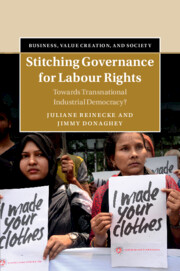Book contents
- Stitching Governance for Labour Rights
- Business, Value Creation, and Society
- Stitching Governance for Labour Rights
- Copyright page
- Contents
- Figures and Tables
- Foreword
- Foreword
- Acknowledgements
- Abbreviations
- 1 Introduction
- 2 The Democratic Deficit of Global Supply Chains
- 3 Democratic Representation
- 4 After Rana Plaza
- 5 Representative Alliances in the Creation of the Bangladesh Accord
- 6 Creating Representation through Industrial Democracy versus CSR
- 7 When Transnational Governance Meets National Actors
- 8 Building Representative Structures at the Workplace Level
- 9 Conclusion
- Book part
- References
- Index
5 - Representative Alliances in the Creation of the Bangladesh Accord
Published online by Cambridge University Press: 09 March 2023
- Stitching Governance for Labour Rights
- Business, Value Creation, and Society
- Stitching Governance for Labour Rights
- Copyright page
- Contents
- Figures and Tables
- Foreword
- Foreword
- Acknowledgements
- Abbreviations
- 1 Introduction
- 2 The Democratic Deficit of Global Supply Chains
- 3 Democratic Representation
- 4 After Rana Plaza
- 5 Representative Alliances in the Creation of the Bangladesh Accord
- 6 Creating Representation through Industrial Democracy versus CSR
- 7 When Transnational Governance Meets National Actors
- 8 Building Representative Structures at the Workplace Level
- 9 Conclusion
- Book part
- References
- Index
Summary
Central to our argument is that “representation gaps” may be filled to some extent by alliances being built by actors at different points in the supply chain and based on the two different logics of representation: representation as structure and representation as claim. Using the Accord as the empirical context, Chapter 5 analyses how and when representation as claim and representation as structure can become complementary: labour rights NGOs can use their power to agitate and mobilise in ways that empower trade unions to negotiate with global brands, while trade unions provide the legitimacy and access to negotiation with global brands. This complementarity is illustrated by the Bangladesh Accord. The Accord emerged as a negotiated and legally binding agreement between Global Union Federations, NGOs and over 200 brands, providing an unprecedented mechanism of transnational co-determination at the supply chain level between representatives of labour and capital.
Keywords
- Type
- Chapter
- Information
- Stitching Governance for Labour RightsTowards Transnational Industrial Democracy?, pp. 89 - 118Publisher: Cambridge University PressPrint publication year: 2023

